#branwell bronte
Text
Flashback: Adam Nagaitis as an art model for Vanessa Garwood's 'King Robin' painting, 2015
(+ 'The Gun Portrait' of the Brontë family)

I love the fact that Adam posed for a painting! Even if the character is not the kindest one. (When was it an obstacle for him, right? 🙂)
Vanessa Garwood describing her work on Instagram (https://instagram.com/vanessagarwood?igshid=MzRlODBiNWFlZA==)

Work in progress, the closeup:
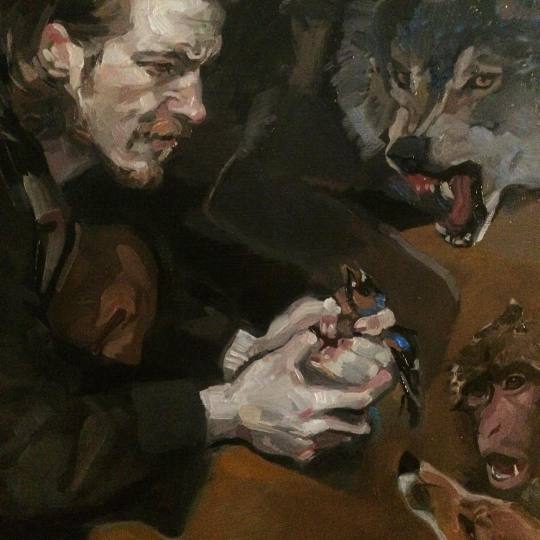
Adam posing:
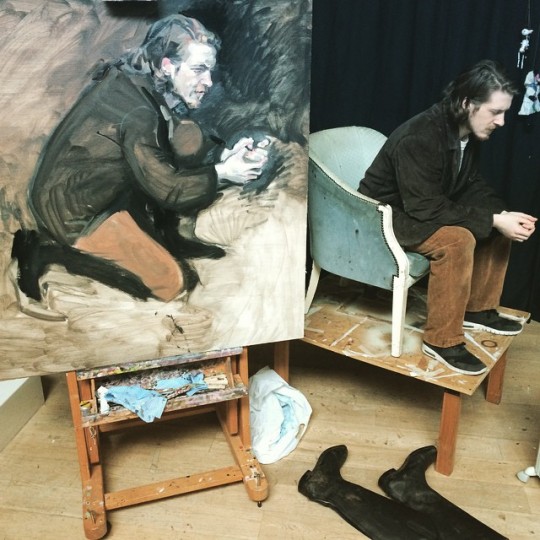
BONUS:
Gudgett-haired Adam with the finished work:

BONUS #2 (To fit it all in one post):
'The Gun Portrait' of the Brontë family, recreated by Timna Woollard for 'To Walk Invisible', with the actors as art models.
Resides at the Brontë Parsonage Museum.
(Timna Woollard's Instagram: https://instagram.com/timnawoollard?igshid=MzRlODBiNWFlZA==)

The photo:
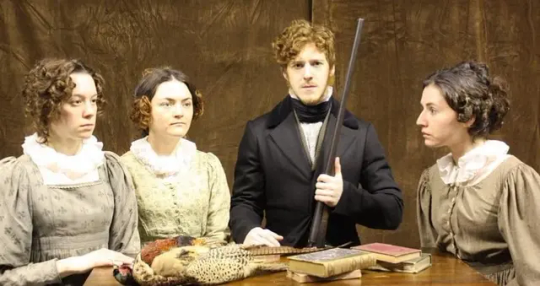
#adam nagaitis#cornelius hickey#amc the terror#the terror#the terror amc#houdini & doyle#oil painting#the terror cast#fine art#to walk invisible#branwell bronte#charlotte bronte#emily bronte#Vanessa Garwood
351 notes
·
View notes
Text

Caricature of Brontē siblings from an old issue of "Punch" magazine.
Source: The Official Bronte Group on Facebook
#charlotte bronte#emily bronte#anne bronte#branwell bronte#jane eyre#villette#shirley#wuthering heights#agnes grey#the tenant of wildfell hall#tenant of wildfell hall#punch magazine#bronte sisters#bronte family
94 notes
·
View notes
Photo
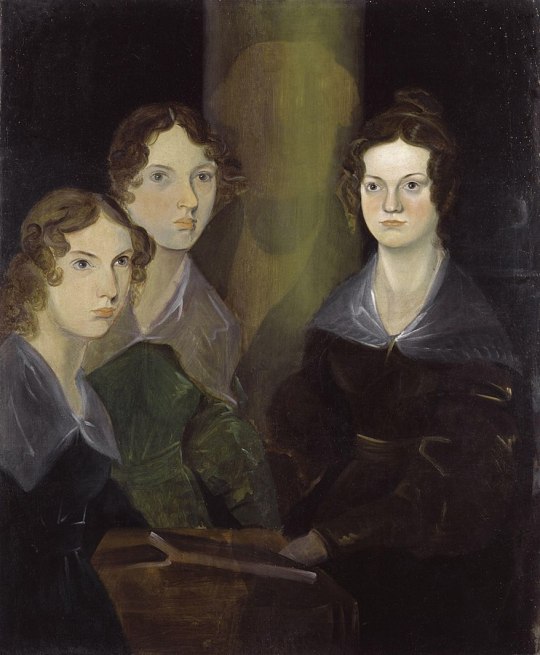
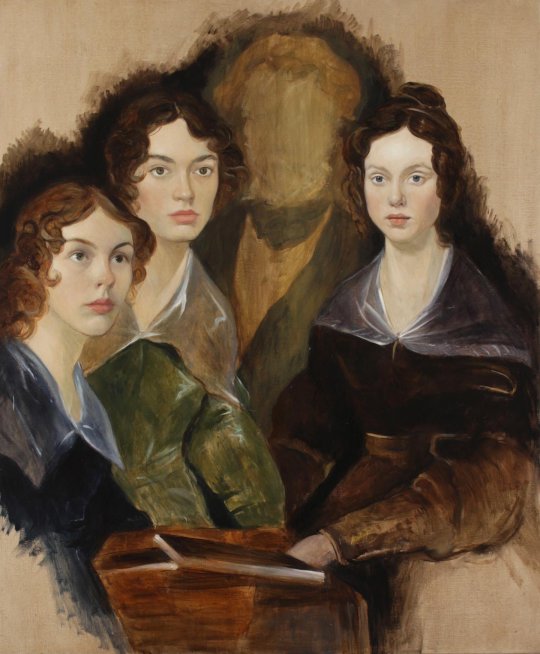
The Brontë Sisters by Patrick Branwell Brontë, restored // The Brontë Sisters as depicted in the 2022 film Emily, by Desmond Mac Mahon
#emily 2022#the bronte sisters#emily bronte#charlotte bronte#anne bronte#branwell bronte#emma mackey#alexandra dowling#amelia gething#making a new post since the artist for the movie posted pics#and i can have a better side by side comparison#again i really love that the movie did this and can't wait to see it in action#*seagull voice* mine#y'all should check out desmond's website#he's done portraits for a bunch of other films and tv shows
435 notes
·
View notes
Text
Read good portions of The Art of the Brontës by Christine Alexander (https://archive.org/details/artofbrontes0000alex) and The Brontë Cabinet: Three Lives in Nine Objects by Deborah Lutz https://archive.org/details/brontcabinetthre0000lutz.
I highly recommend both. They're very well-written books which explore the Brontës through the lens of material culture, which I love. Both novels are essentially collective biographies inspired by and centered around the personal artifacts of the Brontës, which may sound like a limited method of exploration, but by no means is! They contain a wealth of information which I feel has expanded my knowledge bank as a relative beginner to Brontë biography.
#book reviews#book review#book recommendations#the brontes#the brontë sisters#the bronte sisters#emily bronte#charlotte bronte#anne bronte#branwell bronte#fanart#19th century#victorian#lord byron#byronic hero#byronic heroes#book recs#literature#english literature#biographies
25 notes
·
View notes
Text






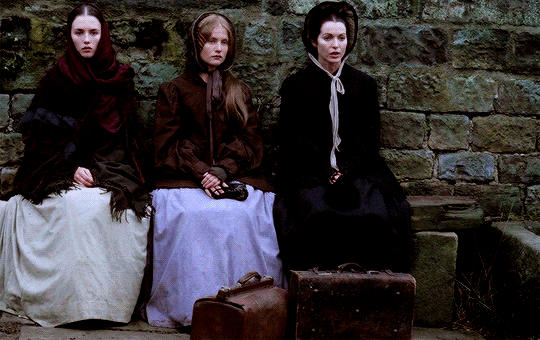


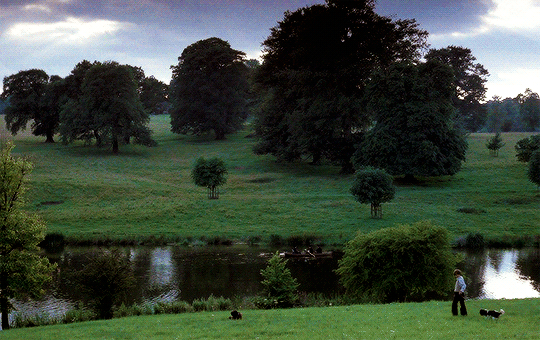
THE BRONTË SISTERS (1979)
Dir. André Téchiné
#the brontë sisters#the bronte sisters#the brontë sisters (1979)#les soeurs brontë#les sœurs brontë#bronteedit#emily bronte#emily brontë#charlotte bronte#anne bronte#branwell bronte#period drama#our gifs#our creations
166 notes
·
View notes
Text
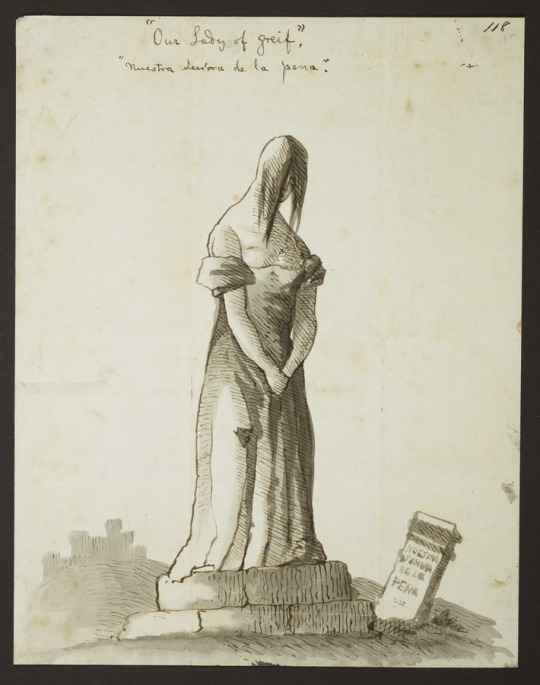
Branwell Brontë 'Our Lady of Greif'
#branwell bronte#brontë#gothic#dark academia#charlotte bronte#emily bronte#anne bronte#jane eyre#wuthering heights#the bronte sisters#lord byron#romanticism
92 notes
·
View notes
Text
We decided to make a fan site about Adam Nagaitis because we can't afford to take out billboards to tell everyone how great we think he is. It just went live yesterday, and there's more things to come on it. :)
#adam nagaitis#cornelius hickey#the terror#quinn#the walking dead#twd daryl dixon#the responder#Private Buckley#Banished#branwell bronte#to walk invisible#gunpowder milkshake#virgil#houdini and doyle#Sgt George Gudgett#red rose#Rick Bennet#chernobyl hbo#Vasily Ignatenko
14 notes
·
View notes
Photo
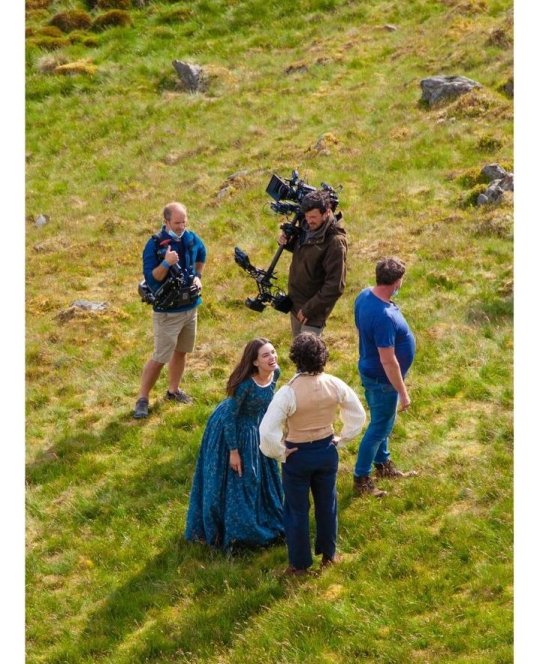

New photos of Fionn and Emma on set of ‘Emily’.
(via IG: christopermurrayholt)
#fionn whitehead#emma mackey#new content#emily 2022#wuthering heights#emily bronte#branwell bronte#on-screen sibling superior
86 notes
·
View notes
Text
Some further comments on those Don Giovanni program notes I just reblogged:
(1) I do think the way the program notes apply each of the Seven Deadly Sins to the opera's non-Giovanni characters is interesting. I don't necessarily agree with all the choices, though. I would never think to name "envy" as Donna Elvira's sin: yes, she wants a man who isn't "hers" anymore, but she doesn't envy the other women he seduces, she tries to protect them from him. I'm not sure if I agree with their choice of "lust" for Donna Anna either. But I like the way they did it. If they had to choose "lust" as Anna's sin, I'm glad that instead of taking the popular route and imagining that she lusts after Don Giovanni, they claim that her fatal flaw was lust for Don Ottavio, because she let the man she thought was him into her bedroom, despite how unseemly that would have been in their time and place. I wouldn't mind seeing more productions take that view of her. The idea that she blames herself for her own sexual assault and her father's death because she gave too much into her passion for Ottavio is a valid one. It would explain why she refuses to let Ottavio console her or even think of marrying him until her mourning is done, without claiming that she doesn't really love him.
(2) It's interesting to see Lady Caroline Lamb's famous quote about Lord Byron, "Mad, bad, and dangerous to know," applied to Don Giovanni. It fits, of course, but it stands out for me because I've only seen that quote applied to one other man besides Byron himself. A man associated with moody Romantic literature because his sisters wrote it: Branwell Brontë. And I had just been thinking that Christopher Maltman's Don Giovanni in the 2008 Salzburg production – the Don who's slowly and painfully dying throughout the opera, but trying to pretend he isn't – reminds me of the stories of two of the Brontë siblings' deaths. First, Branwell, with his alcohol, drugs, and love affairs, the fact that he seems to have ignored his illness and stayed up and about in the village until just a few days before he died, and the legend that at the very end, either to emulate the Roman emperor Vespasian or just to prove the power of human will over bodily weakness, he insisted on getting out of bed and died standing up. (I don't know if that story is true or not, though – Charlotte's letters never mention it.) Second, Emily, who also stubbornly ignored her illness, refused to see a doctor or take medicine, and struggled to go about her normal life for as long as she was physically able. Of course they were dying of tuberculosis, not a bullet in the stomach. But I still imagine that for their sisters, their father, and the servant women Tabby and Martha, helplessly watching them was a process very much like what poor Leporello goes through in that Don Giovanni production.
#opera#don giovanni#thoughts#donna elvira#donna anna#the brontes#branwell bronte#emily bronte#tw: death
10 notes
·
View notes
Text
Thoughts on Emily (2022)
Yeah yeah, not accurate at all, but but but as a translation of the themes of Wuthering Heights (and may I add, Jane Eyre and Vilette) into the lives of the Brontë siblings…… I’m speechless
First, disclaimer, I do not condone the heterosexuality and like to think of Emily as someone who could conjure up all those feelings of desire, hatred, longing, without having to undergo a love affair in the process. But it would’ve been so easy to come up with a Heathcliff to Emily’s Cathy, and I think the movie avoided this in the best way possible. It seemed to me that Emily’s proximity to both Branwell and William was there to show her the possibility of expansion of the self, duality found within a “best earthly companion” (to borrow from Charlotte), while not making neither of them Heathcliff. Both Heathcliff and Cathy were rather in the emotions that these relationships stirred within Emily, getting to the heart of Cathy’s cry of “I am Heathcliff”. It’s Emily who cries “let me in”, it’s Emily who’s left in the abyss. Moreover, I adored the scene where William tells Emily she’s not a fish in the pond of Haworth, but a fish in the deep ocean of the moors. The impression the moors give of being frozen waves, together with the constant howling of the wind, falling of the rain, and crashing of the waves in the soundtrack stirred all the sensuality of the landscape, Emily’s expansion into it and her belonging solely in that wilderness.
Second, I do not condone of Charlotte’s portrait either - at times, it seemed lazy black-and-white setting of the prim vs the rebellious sister. That being said, I forgave it all at the final scene, when Charlotte sits by Emily’s desk and feels Inspiration coming through the window. If we look at the portrayal of Charlotte as that of a time when she was at her most repressed, shutting off everything that made her truly herself for worldly approval, then the final scene serves to recognise the fiery passion, wilderness, and desolation that exists too in her prose. The torch of passion is lit in her for writing Jane Eyre, and most devastatingly, so is that of solitude, made so poignant in the character of Emily, and which will haunt Charlotte even more after her sisters’ deaths, to the writing of Vilette.
So, though Emily (2022) had 2 things that are pet peeves of mine in interpretations of the Brontës’ lives, it left me in the end with the swollen heart of one who had just finished WH/JE/V for the first time, a feeling I’d thought I’d never have again. So I guess I loved it.
#emily 2022#emily bronte#charlotte bronte#anne brontë#branwell bronte#wuthering heights#jane eyre#vilette#The only thing that truly bothered me was the lack of spectacles in Charlotte for most of the movie#That girl had such bad eyesight…. she can’t see anything your honour#It also had the quality of stirring sentiments of disturbance akin to those of the books#when Reason is saying NO and Heart if saying YES to whth is going on#and also… the sibling scenes shattered my heart
30 notes
·
View notes
Text
Watching TWI for a new edit and i just can't believe i found this moment! Tell me you see it too, at the end, the exact second where Branwell unexpectedly turns off, and Adam appears!! So precious ❤️
37 notes
·
View notes
Photo


The Brontë Sisters by Patrick Branwell Brontë, restored // The Brontë Sisters as depicted in the 2022 film Emily
#emily 2022#the bronte sisters#branwell bronte#emily bronte#charlotte bronte#anne bronte#emma mackey#alexandra dowling#amelia gething#again i love that they recreated the painting with the actresses#*seagull voice* mine
84 notes
·
View notes
Text




Mini books created by Charlotte and Branwell Brontë when they were ~13/14 years old.
“Measuring about 2.5 by 5 centimeters, page after mini-page brims with poems, stories, songs, illustrations, maps, building plans, and dialogue. The books, lettered in minuscule, even script, tell of the “Glass Town Confederacy,” a fictional world the siblings created for and around Branwell’s toy soldiers, which were both the protagonists of and audience for the little books. In 1829 and 1830, Charlotte and Branwell cobbled the pages together from printed waste and scrap paper, perhaps cut from margins of discarded pamphlets. They wrote with steel-nibbed pens, which tend to blot, yet the even script demonstrates their practiced hand. Charlotte, who in adulthood wrote “Jane Eyre,” nested leaves together, then neatly sewed the spine with embroidery thread; it’s evident she constructed her book and planned its content before ever putting pen to paper. Branwell, who would become a painter and poet, stacked folded leaves together, which allowed him to add pages as he needed; clearly not as adept with needle and thread as his sister, he stab-sewed the leaves together with thicker linen yarn.”
#bronte family#charlotte bronte#branwell bronte#emily bronte#anne bronte#literature#oddities#curiousities#interesting#history#artefacts#museums#classic literature#english literature#academia
143 notes
·
View notes
Text
I hope you fall in love someday, so you can bleed like the rest of us.
Branwell Brontë, Emily (2022)
21 notes
·
View notes
Text

'A Parody', a Gothic sketch by Branwell Brontë
#branwell bronte#brontë#gothic#dark academia#charlotte bronte#emily bronte#anne bronte#jane eyre#wuthering heights#the bronte sisters#lord byron#romanticism
82 notes
·
View notes
Text
"EMILY" (2022) Review

"EMILY" (2022) Review
I have been aware of only four productions that served as biopics for the Brontë family. I have seen only three of these productions, one of them being a recent movie released in theaters last year. This latest movie, the first to be written and directed by actress Frances O'Connor, is a biopic about Emily Brontë titled "EMILY".
This 2022 movie began with a question. While Emily Brontë laid dying from tuberculosis, her older sister Charlotte asks what had inspired her to write the 1847 novel, "Wuthering Heights". The story flashed back to 1839, when Charlotte returned home to the Haworth parish in West Yorkshire to visit before her graduation from school. Emily attempts to re-connect with the older sister about her fictional works, but Charlotte merely dismisses her creations as juvenile activities. Around the same time, their father Patrick, the parish's perpetual curate receives a new curate name William Weightman. While Charlotte, younger sister Anne and several young women seem enamored of the handsome newcomer, only Emily is dismissive of him. Emily accompanies Charlotte to the latter's school to learn to become a teacher and their brother Bramwell goes to study at the Royal Academy of Arts. Both Emily and Branwell return shortly to Haworth after as failures. When Branwell manages to find a job as a tutor, the Reverend Brontë charges William to provide French lessons to Emily. What began as lessons in French and religious philosophy lessons, eventually evolves into a romantic entanglement between the pair.
"EMILY" managed to garner a good deal of critical acclaim upon its release in theaters, including four nominations from the British Independent Film Awards. It also won three awards at the Dinard British Film Festival: Golden Hitchcock, Best Performance Award for leading actress Emma Mackey and the Audience Award. I have no idea how much "EMILY" had earned at the U.K. box office. But in North America (the U.S. and Canada), it earned nearly four million dollars. Regardless of this . . . did I believe "EMILY" was a good movie? Did it deserved the accolades it had received not only from film critics, but also many moviegoers?
I cannot deny that the production values for "EMILY" struck me as first-rate. I believe Steve Summersgill did a first-rate job as the film's production designer. I thought he had ably re-created Britain's West Yorkshire region during the early 1840s with contributions from Jono Moles' art direction, Cathy Featerstone's set decorations and the film's art direction. Nanu Segal's photography of the Yorkshire locations created a great deal of atmosphere with moody colors that managed to remain sharp. I found myself very impressed with Michael O'Connor's costume designs. I thought he did an excellent job in not only re-creating fashions from the end of the 1830s to the late 1840s, he also ensured that the costumes worn by the cast perfectly adhered to their professions and their class, as shown below:

However, according to a relative of mine, Emily Brontë's fashion sense had remained stuck in the mid-to-late 1830s, something that the 2016 movie, "TO WALK INVISIBLE" had reflected. On the other hand, "EMILY" had the famous author wearing up-to-date fashion for someone of her class:
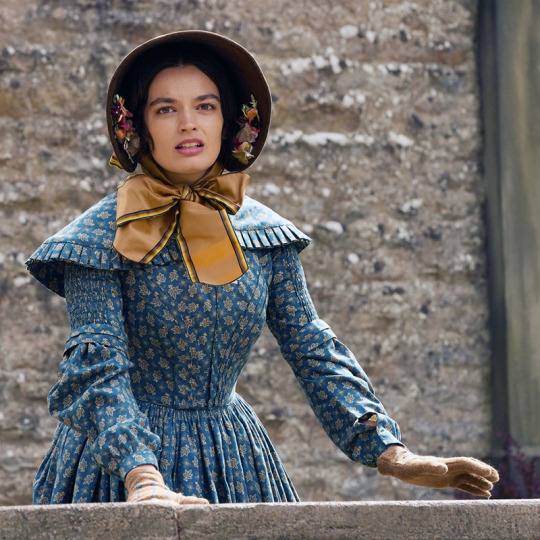
And I must admit that I found those moments featuring actress Emma Mackay wearing her hair down . . . in an era in which Western women did no such thing . . . very annoying. Otherwise, I certainly had no problems with the movie's production values. The movie also included a fascinating scene in which Emily had donned a mask and pretended to be the ghost of the Brontës' late mother during a social gathering. The scene reeked with atmosphere, emotion and good acting from the cast. I also found the scene well shot by O'Connor, who was only a first-time director.
"EMILY" also featured a first-rate cast. The movie featured solid performances from the likes of Amelia Gething as Anne Brontë, Adrian Dunbar as Patrick Brontë, Gemma Jones as the siblings' Aunt Branwell, Sacha Parkinson, Philip Desmeules, Veronica Roberts and other supporting cast member. I cannot recall a bad performance from any of them. The movie also featured some truly excellent performances. One came from Fionn Whitehead, who gave an emotional performance as the Brontë family's black sheep, who seemed overwhelmed by family pressure to succeed in a profession or the arts. Alexandra Dowling gave a subtle, yet charged performance as Charlotte Brontë, the family's oldest sibling (at the moment). Dowling did an excellent job of conveying Charlotte's perceived sense of superiority and emotional suppression. I wonder if the role of William Weightman, Reverend Brontë's curate, had been a difficult one for actor Oliver Jackson-Cohen. I could not help but notice that the role struck me as very complicated - moral, charming, intelligent, passionate and at times, hypocritical. Not only that, I believe Jackson-Cohen did an excellent job of conveying the different facets of Weightman's character. The actor also managed to create a dynamic screen chemistry with the movie's leading lady, Emma Mackey. I discovered that the actress had received a Best Actress nomination from the British Independent Film Awards and won the BAFTA Rising Star Award. If I must be honest, I believe she earned those accolades. She gave a brilliant performance as the enigmatic and emotional Emily, who struggled to maintain her sense of individuality and express her artistry, despite the lack of support from most of her family.
"EMILY" had a great deal to admire - an excellent cast led by the talented Emma Mackey, first-rate production designs, and costumes that beautifully reflected the film's setting. So . . . do I believe it still deserved the acclaim that it had received? Hmmm . . . NO. No, not really. There were two aspects of "EMILY" that led me to regard it in a lesser light. I thought it it was a piss poor biopic of Emily Brontë. I also found the nature of the whole romance between the author and William Weightman not only unoriginal, but also unnecessary. Let me explain.
As far as anyone knows, there had been no romance - sexual or otherwise - between Emily Brontë and William Weightman. There has never been any evidence that the two were ever attracted to each other, or one attracted to the other. Many have discovered that the youngest Brontë sister, Anne, had been attracted to Weightman. In fact, she had based her leading male character from her 1947 novel, "Agnes Grey", on the curate. There have been reports that Charlotte had found him attractive. But there has been no sign of any kind of connection between him and Emily. Why did Frances O'Connor conjure up this obviously fictional romance between the movie's main character and Weightman. What was the point? Did the actress-turned-writer/director found it difficult to believe that a virginal woman in her late 20s had created "Wuthering Heighs"? Did O'Connor find it difficult to accept that Emily's creation of the 1847 novel had nothing to do with a doomed romance the author may have experienced?
Despite Mackey's excellent performance, I found the portrayal of Emily Brontë exaggerated at times and almost bizarre. In this case, I have to blame O'Connor, who had not only directed this film, but wrote the screenplay. For some reason, O'Connor believed the only way to depict Brontë's free spirited nature was to have the character engage in behavior such as alcohol and opium consumption, frolicking on the moors, have the words "Freedom in thought" tattooed on one of her arms - like brother Branwell, and scaring a local family by staring into their window at night - again, with brother Branwell. This is freedom? These were signs of being a "free spirit"? Frankly, I found such activities either immature or destructive. Worse, they seemed to smack of old tropes used in old romance novels or costume melodramas. In fact, watching Emily partake both alcohol and opium reminded me of a scene in which Kate Winslet's character had lit up a cigarette in 1997's "TITANIC", in order to convey some kind of feminist sensibility. Good grief.
What made O'Connor's movie even worse was her portrayal of the rest of the Brontë family. As far as anyone knows, Reverend Brontë had never a cold parent to his children, including Emily. Emily had not only been close to Branwell, but also to Anne. And Branwell was also close to Charlotte. All three sisters had openly and closely supported each other's artistic work. Why did O'Connor villainize Charlotte, by transforming her into this cold, prissy woman barely capable of any kind of artistic expression? Why have Charlotte be inspired to write her most successful novel, "Jane Eyre", following the "success" of "Wuthering Heights", when her novel had been published two months before Emily's? Why did she reduce Anne into the family's nobody? Was it really necessary for O'Connor to drag Charlotte's character through the mud and ignore Anne, because Emily was her main protagonist? What was the damn point of this movie? Granted, there have been plenty of biopics and historical dramas that occasionally play fast and loose with the facts. But O'Connor had more or less re-wrote Emily Brontë's life into a "re-imagining" in order to . . . what? Suggest a more romantic inspiration for the creation of "Wuthering Heights"?
I have another issue with "EMILY". Namely, the so-called "romance" between Brontë and Weightman. Or the illicit nature of their romance. Why did O'Connor portray this "romance" as forbidden? A secret? I mean . . . why bother? What was it about the pair that made an open romance impossible for them? Both Brontë and Weightman came from the same class - more or less. Weightman had been in the same profession as her father. And both had been college educated. Neither Emily or Weightman had been romantically involved in or engaged to someone else. In other words, both had been free to pursue an open relationship. Both were equally intelligent. If the Weightman character had truly been in love with Emily, why not have him request permission from Reverend Brontë to court her or propose marriage to Emily? Surely as part of the cleric, he would have considered such a thing, instead of fall into a secretive and sexual relationship with her. It just seemed so unnecessary for the pair to engage in a "forbidden" or secret romance. Come to think of it, whether the film had been an Emily Brontë biopic or simply a Victorian melodrama with fictional characters, the forbidden aspect of the two leads' romance struck me as simply unnecessary.
What else can I say about "EMILY"? A rich atmosphere filled the movie. The latter featured atmospheric and beautiful images of West Yorkshire, thanks to cinematographer Nanu Segal. It possessed a first-class production design, excellent costumes that reflected the movie's 1840s setting and superb performances from a cast led by the talented Emma Mackey. I could have fully admired this film if it were not for two aspects. One, I thought it was a shoddy take on a biopic for author Emily Brontë that featured one falsehood too many. And two, I found the secretive and "forbidden" nature of Brontë's false romance with the William Weightman character very unnecessary. Pity.

#emily 2022#frances o'connor#emily bronte#bronte sisters#charlotte bronte#anne bronte#emma mackey#oliver jackson cohen#william weightman#wuthering heights#fionn whitehead#branwell bronte#adrian dunbar#gemma jones#alexandra dowling#amelia gething#sacha parkinson#philip desmeules#veronica roberts#gothic romance#period drama#period dramas#costume drama
5 notes
·
View notes